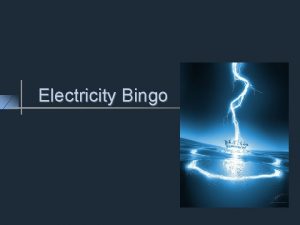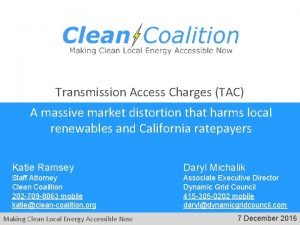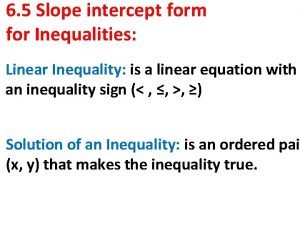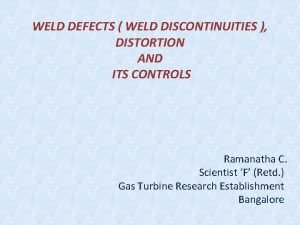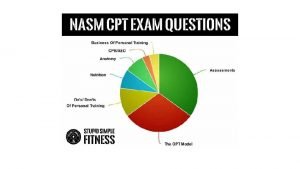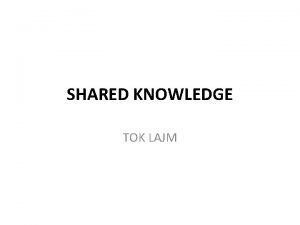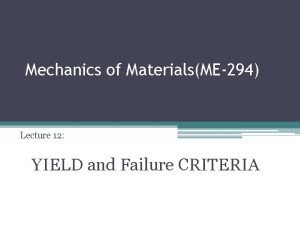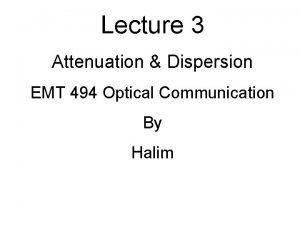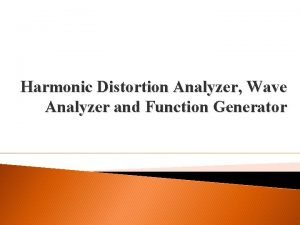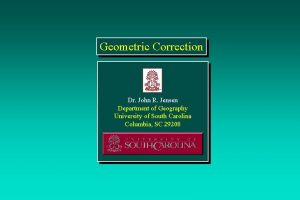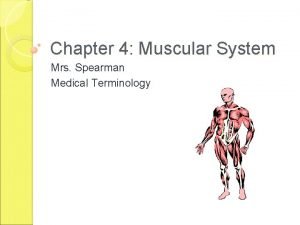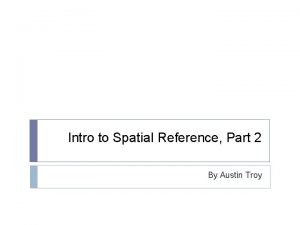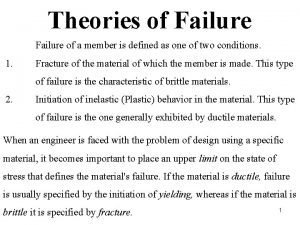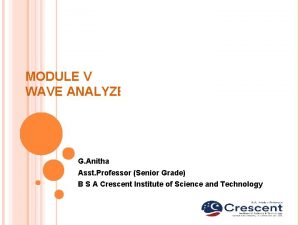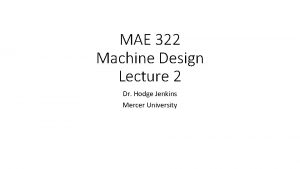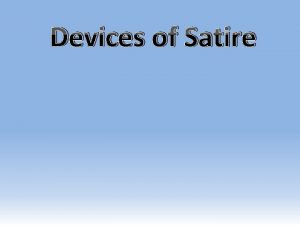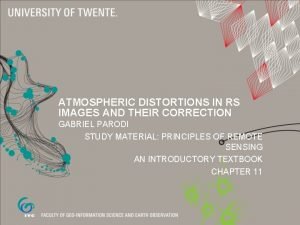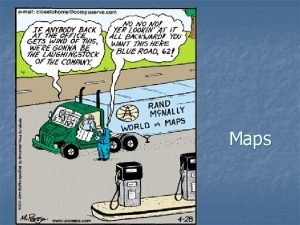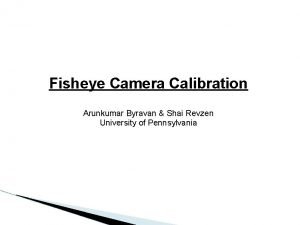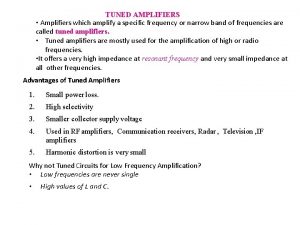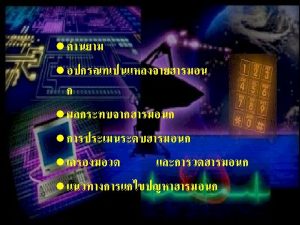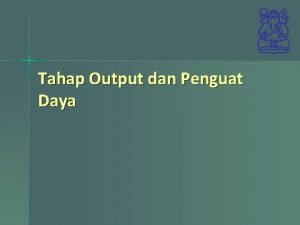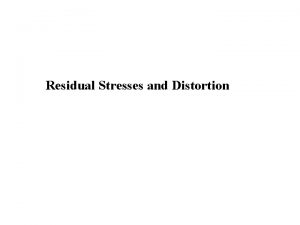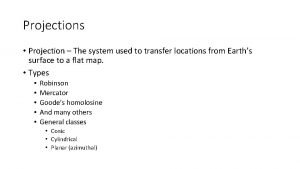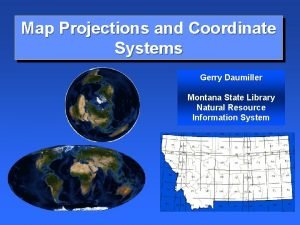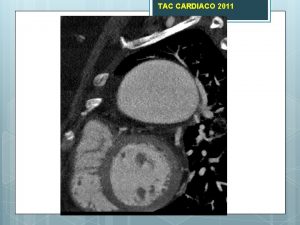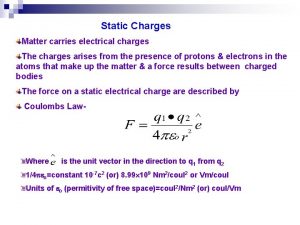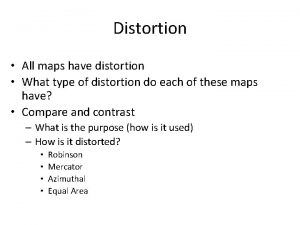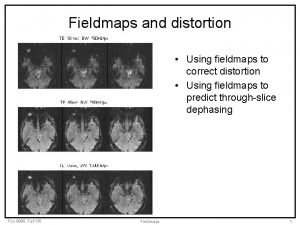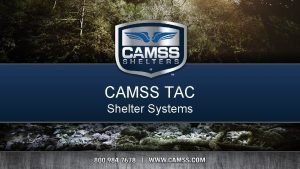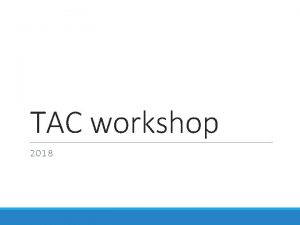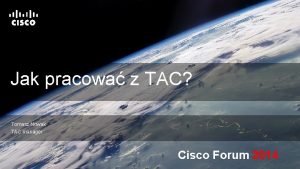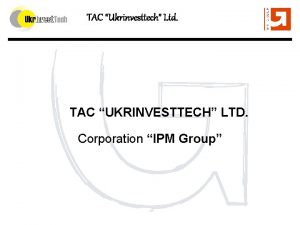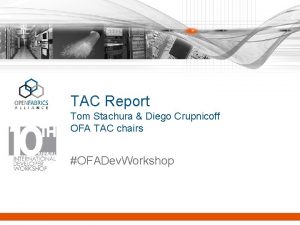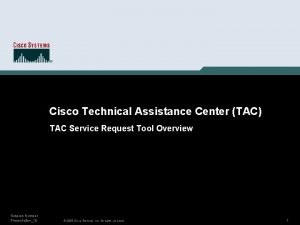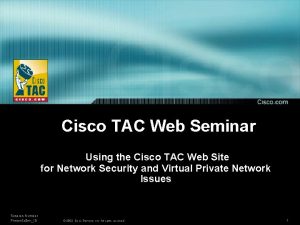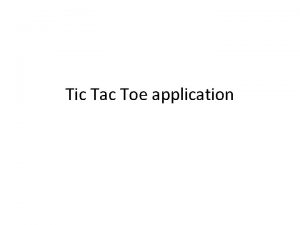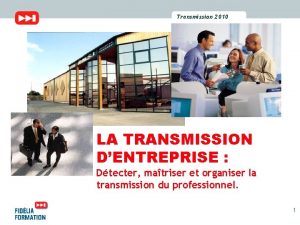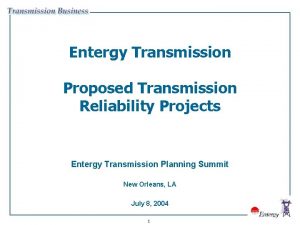Transmission Access Charges TAC A massive market distortion





































- Slides: 37

Transmission Access Charges (TAC) A massive market distortion that harms local renewables and California ratepayers Katie Ramsey Daryl Michalik Staff Attorney Clean Coalition 202 -709 -8063 mobile katie@clean-coalition. org Associate Executive Director Dynamic Grid Council 415 -305 -0202 mobile daryl@dynamicgridcouncil. com Making Clean Local Energy Accessible Now 7 December 2016

Key TAC-related definitions Transmission Access Charges (TAC) Per k. Wh fees for using the CAISO-controlled transmission grid. There are Low Voltage (LV) and High Voltage TAC. Transmission Energy Downflow (TED) Energy that downflows across defined transmission interfaces points Two existing points: HV-to-LV and LV-to-Distribution. Under CAISO expansion there would be a third point: Super HV-to-HV. Correct metering basis for assessing TAC. Customer Energy Downflow (CED) Energy that downflows from the distribution grid across customer meters. Incorrect metering basis for assessing TAC. Participating Transmission Owner (PTO) Entity that owns part of the CAISO-controlled transmission grid. TAC correction is needed in PTO utility service territories (IOUs). Non-PTO utilities (munis) are already handled correctly for TAC. Making Clean Local Energy Accessible Now 2

Agenda 1. TAC distortion overview and our proposed solution 2. Who benefits from the fix? 3. Why resolve the TAC before CAISO expansion? 4. CAISO’s delays to date 5. Next steps & how to get involved Making Clean Local Energy Accessible Now 3

Distributed Generation (DG) = Wholesale DG and Retail DG export (often referred to as NEM export) Project Size Central Generation Serves Remote Loads 50+ MW Wholesale DG Serves Local Loads 500 k. W Retail DG Serves Onsite Loads 5 k. W Behind the Meter Making Clean Local Energy Accessible Now Distribution Grid Transmission Grid 4

Ratepayers benefit through avoided transmission costs Forecasted PG&E Total TAC Rate $ 0. 050 $ 0. 045 TAC rate ($/k. Wh) $0. 03/k. Wh when levelized over 20 years $ 0. 040 $ 0. 035 Business As Usual (BAU) $ 0. 030 The 20 -year levelized TAC is about 3 cents/k. Wh, which is roughly 50% of the current wholesale cost of new energy contracts in California! $ 0. 025 $ 0. 020 $ 0. 015 1 2 3 4 5 6 7 8 9 10 11 12 13 14 15 16 17 18 19 20 2016 - 2035 Making Clean Local Energy Accessible Now 5

TAC metering fix is needed Proper interface for metering all High Voltage TAC (based on TED) Proper interface for metering all Low Voltage TAC (based on TED as is already done in non-PTO utility service territories) Current interface for metering TAC in PTO utility service territories (at customer meters based on Customer Energy Downflow) Making Clean Local Energy Accessible Now 6

CAISO expansion poses high risks for California • CAISO is pushing to expand its balancing authority area and is expected to introduce relevant legislation in January 2017 • CAISO’s expansion will likely include large investments in Super-High Voltage (SHV) transmission that connects sub-regions • Key issues: creating a new governance structure with reduced California governmental control, allocating transmission costs between sub-regions Image source: CAISO Making Clean Local Energy Accessible Now 7

CAISO’s Current Transmission Market Structure CAISO Transmission Facilities California HV TAC based on CED (PTO) and TED (non-PTO) High Voltage (HV) TAC Other utilityspecific LV TAC SDG&E-specific LV TAC Low Voltage (LV) TAC SCE-specific LV TAC PG&E-specific LV TAC 200 k. V 69 k. V Distribution Grid Making Clean Local Energy Accessible Now 8

Clean Coalition’s TED-based SHV allocation reduces risk for California Super High Voltage (SHV) TAC Regionalized ISO SHV TAC socialized across the regionalized ISO based on SHV-HV TED ONLY if new, 300+k. V projects with interties between sub-regions 300 k. V High Voltage (HV) TAC California sub-region HV TAC based on HVLV TED Sub-region 2 HV TAC does not need to change Sub-region X HV TAC does not need to change LV TAC does not need to change Other utilityspecific LV TAC SDG&E-specific LV TAC SCE-specific LV TAC Low Voltage (LV) TAC PG&E-specific LV TAC 200 k. V 69 k. V The SHV-HV firewall protects each sub-region from HV & LV transmission investments that serve other subregions. Similarly, the HV -LV firewall currently protects each utility service territory in CAISO from LV transmission investments that serve other utility service territories. Distribution California retains control of its HV & LV TAC Making Clean Local Energy Accessible Now 9

TED-based TAC: simple & objective Making Clean Local Energy Accessible Now 10

Agenda 1. TAC distortion overview and our proposed solution 2. Who benefits from the fix? 3. Why resolve the TAC before CAISO expansion? 4. CAISO’s delays to date 5. Next steps & how to get involved Making Clean Local Energy Accessible Now 11

Ratepayers benefit through avoided transmission costs Forecasted PG&E Total TAC Rate $ 0. 050 $ 0. 045 TAC rate ($/k. Wh) $0. 03/k. Wh when levelized over 20 years $ 0. 040 $ 0. 035 Business As Usual (BAU) $ 0. 030 $ 0. 025 $ 0. 020 $ 0. 015 1 2 3 4 5 6 7 8 9 10 11 12 13 14 15 16 17 18 19 20 2016 - 2035 Making Clean Local Energy Accessible Now 12

Ratepayers benefit through avoided transmission costs Forecasted PG&E Total TAC Rate $ 0. 050 Notes & Assumptions 12. 4% $ 0. 045 TAC rate ($/k. Wh) $0. 03/k. Wh when levelized over 20 years $ 0. 040 17. 3% Year 20 share of 22. 2% total load served by DG $ 0. 035 $ 0. 030 $ 0. 025 31. 5% $ 0. 020 • All 3 scenarios assume generation from new DG never exceeds new load Business As Usual (BAU) Post-TAC fix Scenario 1: Total DG added per year 1. 5 x of BAU Post-TAC fix Scenario 2: Total DG added per year 2 x of BAU Post-TAC fix Scenario 3: Total DG added per year 3 x of BAU $ 0. 015 1 2 3 4 5 6 7 8 9 10 11 12 13 14 15 16 17 18 19 20 Year after TAC Fix implementation Making Clean Local Energy Accessible Now 13

Ratepayers benefit through avoided transmission costs Forecasted PG&E Total TAC Rate $ 0. 050 $ 0. 045 TAC rate ($/k. Wh) $0. 03/k. Wh when levelized over 20 years $23. 5 billion TAC savings vs. BAU $ 0. 040 $38. 5 billion TAC savings vs. BAU $ 0. 035 $ 0. 030 $ 0. 025 $63. 9 billion TAC savings vs. BAU $ 0. 020 $ 0. 015 1 2 3 4 5 6 7 8 9 10 11 12 13 14 15 16 17 18 19 20 Year after TAC Fix implementation Making Clean Local Energy Accessible Now Ratepayer avoided TAC costs over 20 -year period in the 1. 5 x, 2 x, and 3 x BAU DG scenarios 14

DG Developers benefit from full valuation of DG resources LCBF under Corrected TAC Assessment System LCBF under Distorted TAC Assessment System $120 TAC Costs $100 Generation Cost $80 $60 Winning contract price $40 $20 $0 Cost in $/MWh $120 TAC Costs $100 Generation Cost $80 $60 Winning contract price $40 $20 $0 Central Generation DG Project serving Project local loads • Current TAC assessment unfairly increases the cost of local distributed generation (DG) even though it almost never uses the transmission system • Fixing the TAC market distortion makes local generation more competitive • Over time, more local generation will be built, decreasing the need for transmission upgrades, and decreasing overall system costs Making Clean Local Energy Accessible Now 15

Cost effect example: immediate 2016 Scenario LSE Customer Energy Downflow (CED, in GWh) IOU CCA ESP Total Notes 70 30 10 110 64% 27% 9% 100% NA NA NA $1, 650 $0. 0150 $0. 0150 $1, 050 $450 $1, 650 DG (GWh) 2. 8 1. 2 0 4 Share of LSE CED served by DG 4% 4% 0% 4% 67. 2 28. 8 10 106 63. 4% 27. 2% 9. 4% 100% NA NA NA $1, 650 $0. 0157 $0. 0157 TED-based TAC payments (in $1, 046 thousands) (-$4) Making Clean Local Energy Accessible Now $448 (-$2) $156 (+$6) $1, 650 % of Total CED TRR (in thousands) TAC Rate per k. Wh (now) TAC payment (in thousands) TED (GWh) % of TED TRR (in thousands) TED-based TAC Rate (per k. Wh) Current TAC wholesale billing determinant Share of total TAC basis (now) Total Transmission Revenue Required TRR/CED TAC Rate x CED 4% is the highest current % of DG in any PTO utility service territory Proposed TAC basis Share of total TAC basis (proposed) Remains unchanged TRR/TED New TAC Rate x TED 16

Cost effect example: long term (2 x BAU DG Scenario) 2035 Scenario LSE Customer Energy Downflow IOU CCA ESP Total Notes (CED; in GWh) % of Total CED 70 30 10 110 64% 27% 9% 100% Share of total TAC basis (now) TRR (projected 2035, in thousands) NA NA NA $5, 740 Total Transmission Revenue Requirement TAC Rate per k. Wh (projected 2035) $0. 052 TRR/CED TAC payment (in thousands) $3, 653 $1, 565 $522 $5, 740 TAC Rate x CED DG (GWh) 8. 00 12. 00 0. 00 20. 00 18% energy sourced below T-D interface Share of total LSE CED served by DG 11% 40% 0% 18% Increased to 2 x BAU case TED (GWh) 62. 00 18. 00 10. 00 90. 00 Proposed TAC basis % of TED 68. 9% 20. 0% 11. 1% 100. 0% NA NA NA $4, 470 $0. 0497 TRR/TED; TRR is reduced to DG meeting share of load growth $3, 079 $894 $497 $4, 470 New TAC Rate x TED (and change from business-as-usual) (-$573) (-$671) (-$25) TRR (in thousands) TED-based TAC Rate per k. Wh (projected 2035) TED-based TAC payments (in thousands) Savings Making Clean Local Energy Accessible Now Current CED and TAC basis Share of total TAC basis (proposed) Reduced (due to deferred need for new capacity) 17

NEM customers benefit from higher values for exports Alameda Municipal Power (AMP) released their plan to credit their customers with DG resources for avoided transmission charges, meaning participating customers will see higher payouts for their exported energy. $0. 07 Cost $/k. Wh Avoided transmission charges $0. 05 Capacity & & REC value Capacity & REC value Generation AMP’s Previous Net Energy Metering (NEM) Export Value AMP’s Current DG Renewable Export Value $0. 03 Making Clean Local Energy Accessible Now 18

LSEs with significant DG resources benefit from more competitive pricing Marin Clean Energy (MCE) 2016 service offerings • MCE defines local as “located in an MCE member community” • Based on a typical usage of 463 k. Wh at current PG&E rates and MCE rates effective September 1, 2016 under the Res 1/E-1 rate schedule. Actual differences may vary depending on usage, rate schedule, and other factors. Estimate is an average of seasonal rates. Making Clean Local Energy Accessible Now 19

LSEs with significant DG resources: TAC fix saves 33% of local solar premium Potential Marin Clean Energy savings for 100% local solar All-In cost per k. Wh $ 0. 30 $0. 06 premium now $/k. Wh $ 0. 25 $0. 04 premium after TAC fix $ 0. 20 TAC fix $ 0. 15 All-In cost per k. Wh $ 0. 10 $ 0. 05 $MCE Deep Green Making Clean Local Energy Accessible Now MCE Local Sol 20

Agenda 1. TAC distortion overview and our proposed solution 2. Who benefits from the fix? 3. Why resolve the TAC before CAISO expansion? 4. CAISO’s delays to date 5. Next steps & how to get involved Making Clean Local Energy Accessible Now 21

Why fix TAC before regionalization? 1) SIMPLICITY: The Clean Coalition’s SHV proposal simplifies cost allocation for regionalization. Our proposal is more straightforward than CAISO’s current proposal. 2) PRESERVES CALIFORNIA POLICY PRIORITIES: The SHV proposal resolves the TAC question and preserves California’s policy priorities and commitment to renewable energy, including DG resources. 3) HEDGES AGAINST DILUTED GOVERNANCE: Our proposal fixes the cost allocation mechanisms for all levels of TAC and hedges against diluted governance. In a regionalized ISO, California will not have as much control over the market signals for energy resources. Making Clean Local Energy Accessible Now 22

Agenda 1. TAC distortion overview and our proposed solution 2. Who benefits from the fix? 3. Why resolve the TAC before CAISO expansion? 4. CAISO’s delays to date 5. Next steps & how to get involved Making Clean Local Energy Accessible Now 23

Timeline of key events shows CAISO avoiding fix Apr: CAISO agrees with CC on basic facts of TAC market distortion May: CAISO announces will address TAC market distortion in Wholesale Billing determinant (WBD) initiative Mar: CAISO announces will address TAC market distortion in ESDER Phase 2 initiative 2015 CAISO admits DG reduces transmission investment Jan: CAISO regionalization Sep: CAISO closes WBD initiative, legislation, including does not address factual disputes SHV TAC Nov: CAISO announces 2017 Review TAC Structure initiative 2016 Nov: CC testifies in front of CAISO Bo. G about the TAC market distortion in TAC Options initiative Apr: CC files TAC fix proposal in ESDER Phase 2 initiative Making Clean Local Energy Accessible Now Jun: CC files detailed TAC fix proposal in WBD initiative. CLECA files comments disputing info provided by CAISO: TAC facts cited in CC proposal, details of TAC billing process 2017 Aug: CA legislative session ends Sep: scheduled end of TAC Structure initiative Nov: CC testifies in front of CAISO Bo. G about the TAC market distortion, urging action and highlighting delays 24

Agenda 1. TAC distortion overview and our proposed solution 2. Who benefits from the fix? 3. Why resolve the TAC before CAISO expansion? 4. CAISO’s delays to date 5. Next steps & how to get involved Making Clean Local Energy Accessible Now 25

How you can help 1. Formally support the TAC Campaign by authorizing use of your logo on the TAC Campaign Supporters web page 2. Write a letter to CAISO & Governor Brown stating you would like the TAC market distortion resolved before CAISO regionalization (template available) 3. Recruit other stakeholders to support the TAC Campaign Making Clean Local Energy Accessible Now 26

The TAC Fix is backed by a broad range of organizations Making Clean Local Energy Accessible Now 27

Getting involved For more information on the TAC Campaign, visit www. clean-coalition. org/tac or email katie@clean-coalition. org Endorse the TAC Campaign • Contact Daryl Michalik, Executive Director of the Dynamic Grid Council daryl@dynamicgridcouncil. com Add your voice directly by filing your own comments to CAISO and key influencers Making Clean Local Energy Accessible Now 28

BACKUP Making Clean Local Energy Accessible Now 29

Why fix TAC before regionalization? Simplicity 1) The Clean Coalition’s SHV proposal simplifies regionalization: our proposal solves the Super-High Voltage cost allocation challenge • CAISO is currently reviewing methods to fairly allocate costs for new transmission facilities under the regionalized ISO, including many categories for facility types, with costs proportionate to benefits via an algorithm yet to be determined • By contrast, the Clean Coalition’s SHV proposal is - Simple - Consistent at all levels of transmission - Objective and transparent; no subjective benefits algorithm that could change over time - A solution to California’s current TAC market distortion harming local renewables, by establishing the concept of measuring transmission usage at transmission interfaces, via Transmission Energy Downflow Making Clean Local Energy Accessible Now 30

Why fix TAC before regionalization? Preserve CA policy priorities 2) Resolving the TAC question with the SHV solution preserves California’s policy priorities: California is committed to renewable energy, including DG • California has unique policy priorities and has taken steps to fairly reflect the value of DG resources • The SHV solution fixes California’s current TAC market distortion harming local renewables, and prevents that market distortion from spreading to other states - communities investing in DG resources will see a financial benefit to limiting the demand for SHV investments - correct market signals for SHV-transmission-dependent resources in comparison to local energy resources • Critical CA procurement decisions are coming soon. Without the TAC fix, California will overspend on transmission assets that result in 50 years of ratepayer expenses Making Clean Local Energy Accessible Now 31

Why fix TAC before regionalization? Hedge against diluted governance 3) Fixing the cost allocation mechanisms for all levels of TAC hedges against diluted governance: in a regionalized ISO, California will not have as much control over the market signals for energy resources • Any changes in CAISO’s governance structure will, by definition dilute California’s management of transmission-related issues, including the market signals for cost of delivery (i. e. TAC) • Fixing any existing market distortions on local renewables will be more difficult in the regionalized ISO, as non-Californian stakeholders will have little interest in ensuring local renewables have accurate pricing signals to fairly compete Making Clean Local Energy Accessible Now 32

Other ISO assess TAC based on TED Use TED to for TAC usage measurement Making Clean Local Energy Accessible Now 33

CAISO delays to date Nov. 2015: Clean Coalition raises TAC market distortion in TAC Options initiative Jan. 2016: CAISO directs comments to the ESDER initiative May 2016: CAISO directs comments to the TAC Wholesale Billing Determinant initiative Jan. 2017: CAISO is expected to introduce regionalization legislation Making Clean Local Energy Accessible Now Sept. 2016: CAISO cancels the TAC Wholesale Billing Determinant initiative; directs comments to new TAC structure initiative for midyear 2017 34

TAC fix unleashes local renewables Forecasted PG&E Total TAC Rate $ 0. 045 11. 0% TAC rate ($/k. Wh) $ 0. 040 $0. 03/k. Wh when levelized over 20 years $ 0. 035 $ 0. 030 Total TAC rate reduction relative to BAU by Year 2, 3 or 4 based on DG growth rate $ 0. 025 $ 0. 020 $ 0. 015 1 2 3 4 5 6 7 8 9 10 11 12 13 14 15 16 17 18 19 20 Year After TAC Fix Making Clean Local Energy Accessible Now 15. 2% Year 20 share of 19. 5% total CED served by DG Notes & Assumptions • All 3 scenarios assume generation from new DG never exceeds new CED Business As Usual (BAU) 27. 6% Post-TAC fix Scenario 1: Total DG added per year 1. 5 x of BAU Post-TAC fix Scenario 2: Total DG added per year 2 x of BAU Post-TAC fix Scenario 3: Total DG added per year 3 x of BAU 35

WDG developer benefits • Makes local generation more competitive in California’s main venues for renewable energy procurement: RPS, Re. MAT, DRP, IDER - Corrects a market distortion harming distributed generation (DG) by recognizing that distributed generation reduces the need for additional transmission investment - Generates ongoing local jobs in O&M after generation built • Incentivizes keeping renewable generation in California, instead of building remote renewables in other states • Prevents the market distortion harming DG from spreading to other states and regions within a regionalized ISO Making Clean Local Energy Accessible Now 36

Policymaker benefits overview • Aligns transmission charges with actual usage, ensuring that costs follow benefits • Corrects a market distortion harming distributed generation (DG) by recognizing that distributed generation reduces the need for additional transmission investment • Provides an objective, straightforward, and transparent methodology for allocating new costs • Enables one consistent TAC methodology at all levels of transmission throughout CAISO and the regionalized ISO • Will save California ratepayers billions of dollars in avoided transmission investments Making Clean Local Energy Accessible Now 37
 Caiso transmission access charges
Caiso transmission access charges Like charges blank and opposite charges blank
Like charges blank and opposite charges blank Caiso
Caiso Market leader challenger follower nicher examples
Market leader challenger follower nicher examples Marketing targeting and positioning
Marketing targeting and positioning Slope intercept form inequalities
Slope intercept form inequalities Underfill defect in welding
Underfill defect in welding Dynamic postural assessment: overhead
Dynamic postural assessment: overhead Power distortion tok
Power distortion tok Portion distortion quiz
Portion distortion quiz Maximum distortion energy theory formula
Maximum distortion energy theory formula Pulse dispersion in optical fiber
Pulse dispersion in optical fiber To combine or paste together multiple elements
To combine or paste together multiple elements Distortion analyzers
Distortion analyzers Geometric corrections
Geometric corrections Dyskinesia is the distortion or impairment of:
Dyskinesia is the distortion or impairment of: Map distortion
Map distortion Perceptual region definition
Perceptual region definition Distortion energy theory formula
Distortion energy theory formula Heterodyne wave analyzer
Heterodyne wave analyzer Mae 322
Mae 322 Low distortion projection
Low distortion projection Child beauty pageants exploitation
Child beauty pageants exploitation Invective satire examples
Invective satire examples Delay distortion in data communication
Delay distortion in data communication Unowned positioning
Unowned positioning Atmospheric distortion correction
Atmospheric distortion correction Dot density map definition ap human geography
Dot density map definition ap human geography What map is this
What map is this Shai revzen
Shai revzen Oid in radiology
Oid in radiology In tuned amplifiers harmonic distortion is
In tuned amplifiers harmonic distortion is Thdi formula
Thdi formula Rangkaian penguat daya
Rangkaian penguat daya Distortion
Distortion Distortion
Distortion Montana utm zones
Montana utm zones Low distortion projection
Low distortion projection

